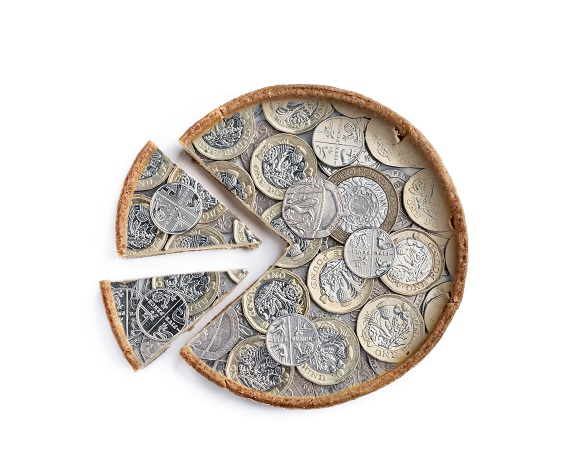US inflation figures are higher than hoped (3.1% v 2.9% expected), jolting the market again and pushing Euro:Sterling to the highest since August 2022 and strengthening the Dollar.
Our inflation at 4% was slightly less than expected but we have now entered ‘Recession’ with ‘two quarters of negative growth’ – good in attacking inflation but not for the ‘economy’. UK unemployment is low and wage growth figures remain high and will jump again in April with the 10% increase in ‘Minimum Wage’.
This suggests that lower interest rates have been pushed further out into the year though there remains optimism for a 2% UK inflation target to be met soon. Higher figures are despite things like a 40% fall since 12 January in natural gas prices (which have plumbed levels last seen in September 2020). If they fall much more, it will be June 2020 lows. I wonder when this will feed through to energy prices – and inflation – if we are still allowed to use gas of course. The S&P500 (the US main market) has just broached 5,000 for the first time. Last year, 70% of its components underperformed that index, showing how the ‘Magnificent Seven’ were the only game. The historical and more balanced average is for nearer 40% of stocks to be under par. In China they have another problem – deflation – prices falling. The impact will percolate across to us in due time and economic growth.
I am reading more and more research commentary about whether the alarm bells for the US market are similar, both before the Dotcom crash or indeed the Great Crash in 1929 – and conflicting arguments saying ‘this time it is different’.
However, when Nvidia can jump into the fourth biggest company position ahead of Google and Amazon and add the whole bloated value of Tesla to its stock market ‘value’ since just the beginning of the year (up 45%), eyebrows have to be raised, surely! British Chip designer Arm jumps 60% on the mention of ‘AI’… and then doubles (before falling back to stand ‘only’ 55% up)… Of course, if there was an almighty upset in the US, what impact would it have on other assets and markets?
Even if those ‘seven’ halved and halved again, on historic criteria they could still be considered ‘expensive’ but would any implosion be limited to them and not be contagious, regardless of how undervalued other assets may be already? What is so important is that the US counts for nigh 70% of the value of all the world’s stocks yet the ‘concentration risk’ of these seven doesn’t seem ever to be flagged as a risk and indeed, certainly not for those encouraging investors to buy ‘cheap passives’ dominated by the same US stocks.
The Dow Jones took thirty years to regain the peak of 1929. Tokyo has still not regained its 1989 peak when it counted for 40% of the world’s markets (I have said it before too but the Dow and Nikkei Dow ‘numbers’ are curiously both close to the Nikkei’s 1989 top…). The Dotcom bubble had 40% of the world’s stocks in technology, telephony and media and look where BT and Vodafone are now, for example, yet how telephony has developed over the same time! Anyway, it is just something of which to be aware. They don’t ring a bell at the top (nor the bottom) and we are doing our utmost to navigate prudently through the mists of myriad assets as well but a ‘value’ bent helps.
So in 2023, investors here withdrew record sums from funds according to the statistics and then in January, it was a record month for new cash (especially thrown at the US)… the best time to have bought was late September 2023…? January should be ok but the value was (and always is) much better when people are rushing for the exit and not the way in. Of course, at the respective times it isn’t easy to tell and human emotions drive short-term market behaviour, making people buy when they are happy and sell when they are worried (more so at the bottom of course when the worst has already happened)…
Life in the day of a financial adviser

Two similar client situations last week. Simple case – small, ‘inherited’ pension pots where each chap wanted to access their money on reaching State Retirement. The process suggested we just help them do that but is that the right thing? No. What they may want and what is best for them are often two very different things. We don’t mean it patronisingly and the size of their pension plans is wholly uneconomic for us to assist but we do – it’s goodwill (and without charge from us) and who knows what might come later.
So, a couple of 30 minute conversations later and I stopped one taking an annuity which he didn’t need, encouraged the other to subscribe a final payment to his plan before he stops work to attract a £10,000 tax rebate which he could then withdraw ‘immediately’, encouraged him to clear his credit card debts to save 18%pa and encouraged him to make a final State Pension contribution to boost his income by £4pw (indexed for life). Plus, to continue his business accounts a while longer and part-time, as well as reclaiming the interest on a Covid business loan his accountant had missed and oh well, just think, we could have just done what they asked and helped them encash their pensions and pay a lump of tax on them instead. Is it all just about ‘investment performance’? Of course not – that’s important but the core value is in the round.
Digital 9 Infrastructure Plc – a thumb-nail sketch

Before anything, I should add that we do not hold a single share in this asset for clients, nor is it a recommendation. However, it is certainly the sort of opportunity we review.
So, in March 2021 as enthusiasm and excitement in the internet continued to roll-out, Triple Point had a good idea to raise an investment ‘pot’ which would invest in sustainable infrastructure ‘underpinning the world’s digital economy’. The Trust started with £300million from investors at £1. Three months later and to satisfy investor appetite, it raised a further £105million at £1.05 and September a further £275million at £1.075. In January 2022, a further £95million was raised at £1.08 and in July, £60million more at £1.10. That December, its successful progress saw the Company join the FTSE250 Index – well done! Along the way, the Company also arranged credit of £375million to allow it to increase the prospective returns to shareholders as the extra profits were expected to exceed interest costs. On top of the capital returns, the Company was paying dividends from some of the returns from these assets – a fair 6p was anticipated each year.
After peaking at £1.18 in August 2021, the Company’s shares have sunk (and some may say for little reason other than investor disinterest and panic as nothing has changed with its initial objectives, views and expectations even if the interest rate backdrop is different).
On 5 February, the Company announced it is going to enter a managed wind-down to return cash to investors, with a projected end date of 2029 (sufficient time to avoid fire sales and to optimise value). Initially this news boosted the shares but since, what seems a final nail in the coffin, the Icelandic authorities have demanded regulatory approval for the $575million sale of its 42% asset (Verne Global) to Ardian France SA which, at best will delay matters and they slumped to 14.5p, valuing the whole Company at nearer £125million. The June 2023 net asset value was £1.0013 per share, with £1.2billion capital deployed. It held £29.5million of unrestricted cash. The Company’s diversified investee companies generated £223million of sales and £106million ‘profits’ over the first half of the year, so a solid outcome. The negativity was compounded by the volcanic action on the other side of its peninsula though the Company says it is wholly unaffected.
In a lesson for the euphoria in the US today, is this simply the extreme difference between excessive investor excitement becoming a friendless asset class and ultimately deranged panic? Yes, borrowing costs have increased and investor calculations for expected returns on low risk assets like infrastructure rebalance, so that can reduce valuations. However, if the Company finds buyers with deeper pockets and longer horizons than it is now afforded by the ‘market’, what will it extract? Will it be half they have paid for these assets already? Of course it will hope to pass-on these attractive projects (with strong income flows) for at least what they have invested in them but prices are usually lower if the buyers know you ‘have’ to sell.
The real point is what are the shares worth today? The price is always what sellers are ‘happy’ to take and there are few buyers as markets hate uncertainty. However, it could well be the case in the end that patient investors receive at least 75p for every share (and remember that whilst it still owns the assets, they still generate revenue. So the first job is to pay-down debt but those income flows will still be coming-in to pay the bills and make a profit). However, even if all you receive is 40p, that’s a 100%+ increase on the present share price and a return divorced from ‘what the stock market is doing today’ to significant extent. Of course, the risks are that that might not happen either – but.
Yes, it is always difficult to value such infrastructure but professionals have to start somewhere and the industries have formulae to give appropriate figures which are then used by such specialist companies. For a going concern and new start-ups, very often it is simply the cost of the asset constructed, or/and the purchase price or costs paid and not what it would ‘fetch’. Of course, a fire sale of assets and swiftly is likely to yield a much reduced sum and a figure which can be very low if it is a liquidator keen to exit quickly and without much heed to ‘value’. However, how much leeway does the current share price give and these assets are generating revenue and profit, so it is not a speculative venture with jam promised tomorrow, so selling should not be impossible – and at good prices.
And do we know what’s sad? There will be investors out there who may hold this asset in their portfolio, even bought at say 30p (if not the £1 launch) or whatever (when it is still hard to challenge as not a value play even then), who will be angry with their portfolio manager’s bad ‘performance’ and will be considering moving their assets away as a result.
Now I have to ask, is it wise to be selling such assets at such depressed levels (fine, if the shares could go to lower levels or zero) as opposed to buying more? No point crying over spilt milk but you MUST look at what the future is likely to hold and not the banal past ‘performance’ in instances like this. Don’t let your manager dump ‘bad’ shares either, just so they don’t show as a thorny reminder on your quarterly valuation so you can throw vitriol at them (yes, some under-pressure managers do dump stuff like this regardless of price too). If it is best to sit-it-out then you need to play your part too. So, when you consider how your manager has ‘performed’ do please look under the bonnet and don’t take the wrong decisions at the wrong time!
The IMF

Thank you David Horner for quoting Liam Halligan, ‘British Economist, Journalist, Author and Broadcaster’ who also did a stint at the IMF. He noted apparently the IMF was wrong with its forecasts 26 out of the last 28 times… so there is hope for us yet! Why do we all put such store on forecasts… more will say ‘Liz Truss was right’ if this continues…
Good news, bad news
 So commercial property companies (REITs) are showing a mixed time. Our recent foray into Regional Property Trust seems premature as the shares have fallen even further to see the market capitalisation drop to just £115million and down from £623million at its February 2020 peak. Of course we didn’t start buying there but the results on 2 February did not inspire the market and the inevitable slight slippage of 5.9% from June’s 30 in the portfolio’s value to £701million (borrowing at £385million so net shareholder equity of over £300million ignoring other assets) was enough to trigger yet more selling. Rent collections at 99% were ignored. Rents totalled £68million with occupancy at 80%. The next dividend will be declared on 24 February.
So commercial property companies (REITs) are showing a mixed time. Our recent foray into Regional Property Trust seems premature as the shares have fallen even further to see the market capitalisation drop to just £115million and down from £623million at its February 2020 peak. Of course we didn’t start buying there but the results on 2 February did not inspire the market and the inevitable slight slippage of 5.9% from June’s 30 in the portfolio’s value to £701million (borrowing at £385million so net shareholder equity of over £300million ignoring other assets) was enough to trigger yet more selling. Rent collections at 99% were ignored. Rents totalled £68million with occupancy at 80%. The next dividend will be declared on 24 February.
Yet others, like UK Commercial Property Trust which clients don’t own, has rebounded by 32% since its 30 June low and one of our larger, Balanced Commercial Property Trust, has likewise seen useful buying interest to propel the shares 26% higher than the 20 October low. Each of these receives considerable rental flows (reflected in good dividends to investors) and whilst the headwinds are typically higher interest borrowing, fears on debt refinancing and valuations of the underlying properties (let alone the difficulty of selling at the moment), how much comfort cushion should investors expect? Remember too that values have already been written-down and of sales proceeding, in general they are not far from surveyors’ figures. Its shares still trade at roughly 35% discount to the latest asset value but this is not a recommendation and yes, we started buying ‘too soon’.
The advisers need to be sharper too on proposed corporate action. Custodian, which was doing comparatively ‘well’ share price-wise, used that advantage to announce a merger (takeover) with Abrdn Property Trust, companies of which we own both. The market has savaged Custodian seeing the shares drop 20% as the market has calculated that buying Abrdn is a cheaper way into the Company on the terms offered. Abrdn went up 17% since August (now flat) but I am minded to vote against the merger and it may be better if Abrdn sells its assets and winds-up over time instead. Abrdn’s asset value is over 80p and a failure should see Custodian bounce back again as well. The deal is only worth 52p for each Abrdn share now and whilst all that added value will accrue in the company with £1billion of property assets so the shares should advance… it’s not compelling. Custodian trades at a 27% discount to its asset value presently.
Why do Britons have so little ready cash?

The Resolution Foundation says that 11.2million working age Britons have less than £1,000 in savings. It also says that less than half of working-age households have more than three months’ income for emergencies.
Not being naïve nor unkind but why is this? Is it because ‘they’ don’t have enough money coming-in or because they haven’t had financial guidance on sensible spending on what they can afford (as opposed to what they may like to have!) and savings? Or is it a combination of the two? From experience too, I have known plenty of people who only seem happy if their finances are in a mess and usually on the wrong side of the line too and where helping them simply encourages them to do more of the ‘wrong things’… are psychological traits involved perhaps as well?
It is recognised that ‘living life for now’ seems much more attractive than for the future but the numbers which have stayed with ‘auto enrol’ for pensions (almost 11million people) show that when ‘forced’ the vast majority can maintain their pension contributions as opposed to having nothing – as was their case before.
The Foundation encourages the Government to better incentivise savers but would that work? And of course the flip side is that those who have such financial issues from whatever reasons (or those who are simply feckless) often have other problems – borrowing on loans, pay-later schemes and credit card debts for example, so that makes it even harder to escape the millstone (and the related mental health pressures) which these can so easily become and to consider having a pot for emergencies at all.
My best wishes
Philip J Milton DipFS CFPCM Chartered MCSI FPFS FCIB
Chartered Wealth Manager
Fellow Of The Personal Finance Society, Fellow Of The Chartered Institute Of Bankers





